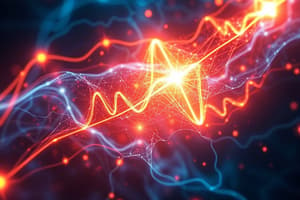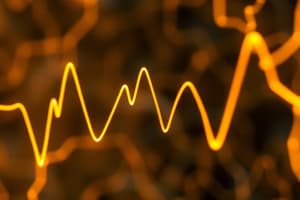Podcast
Questions and Answers
What drives the movement of ions across the cell membrane when channels are open?
What drives the movement of ions across the cell membrane when channels are open?
- Concentration gradient and magnetic fields
- Electric charge alone
- Chemical energy only
- Concentration gradient and electrostatic pressure (correct)
What is the threshold membrane potential required to initiate an action potential?
What is the threshold membrane potential required to initiate an action potential?
- -50 mV (correct)
- -70 mV
- -30 mV
- -90 mV
Which ion is primarily responsible for both passive diffusion out of the cell and electrostatic pressure into the cell in terms of equilibrium potential?
Which ion is primarily responsible for both passive diffusion out of the cell and electrostatic pressure into the cell in terms of equilibrium potential?
- Chloride (Cl-)
- Calcium (Ca+)
- Potassium (K+) (correct)
- Sodium (Na+)
What occurs during the absolute refractory period?
What occurs during the absolute refractory period?
What happens to the membrane during the relative refractory period?
What happens to the membrane during the relative refractory period?
Which two divisions make up the central nervous system (CNS)?
Which two divisions make up the central nervous system (CNS)?
What function does the hypothalamus primarily serve in the limbic system?
What function does the hypothalamus primarily serve in the limbic system?
Which neurotransmitters are primarily associated with the ventral tegmental area (VTA)?
Which neurotransmitters are primarily associated with the ventral tegmental area (VTA)?
What is the primary role of the association cortices in the nervous system?
What is the primary role of the association cortices in the nervous system?
Which part of the limbic system is primarily involved in motivation and voluntary motion?
Which part of the limbic system is primarily involved in motivation and voluntary motion?
Which cells are primarily involved in the electrical transmission within a neuron?
Which cells are primarily involved in the electrical transmission within a neuron?
What is the primary function of the sympathetic division of the autonomic nervous system?
What is the primary function of the sympathetic division of the autonomic nervous system?
Which of the following structures is involved in processing fear and reward?
Which of the following structures is involved in processing fear and reward?
What is the primary function of glial cells in the nervous system?
What is the primary function of glial cells in the nervous system?
Which type of neuron is responsible for converting physical stimuli into electrical signals?
Which type of neuron is responsible for converting physical stimuli into electrical signals?
Which type of glial cell is specifically responsible for producing myelin in the central nervous system?
Which type of glial cell is specifically responsible for producing myelin in the central nervous system?
What part of a neuron is primarily responsible for receiving information from other cells?
What part of a neuron is primarily responsible for receiving information from other cells?
What role do interneurons play in the nervous system?
What role do interneurons play in the nervous system?
Which component of the neuron conducts electrical signals from the cell body to the terminal buttons?
Which component of the neuron conducts electrical signals from the cell body to the terminal buttons?
What is the main function of neurotransmitter receptors located on dendrites?
What is the main function of neurotransmitter receptors located on dendrites?
Which glial cell type is responsible for cleaning up debris in the nervous system?
Which glial cell type is responsible for cleaning up debris in the nervous system?
What role do dendritic spines play in neuron structure?
What role do dendritic spines play in neuron structure?
What is the primary function of the axon in a neuron?
What is the primary function of the axon in a neuron?
Which of the following statements about the myelin sheath is true?
Which of the following statements about the myelin sheath is true?
What are the Nodes of Ranvier responsible for?
What are the Nodes of Ranvier responsible for?
In convergent pathways, how is information processed?
In convergent pathways, how is information processed?
What characteristic of the cell membrane allows for the action of neurotransmitters?
What characteristic of the cell membrane allows for the action of neurotransmitters?
Which statement best describes the structure of a phospholipid in a cell membrane?
Which statement best describes the structure of a phospholipid in a cell membrane?
What type of glial cells myelinate nerves in the peripheral nervous system?
What type of glial cells myelinate nerves in the peripheral nervous system?
What is the primary role of receptor proteins in cell membranes?
What is the primary role of receptor proteins in cell membranes?
Which type of ion channel opens in response to changes in electrical potential across the membrane?
Which type of ion channel opens in response to changes in electrical potential across the membrane?
What describes the resting membrane potential of a neuron?
What describes the resting membrane potential of a neuron?
What process is referred to when a phosphate group is added or removed from an intracellular protein affecting ion channel activity?
What process is referred to when a phosphate group is added or removed from an intracellular protein affecting ion channel activity?
Which statement about ion channels is true when they are open?
Which statement about ion channels is true when they are open?
What ions are typically more concentrated outside a neuron at resting membrane potential?
What ions are typically more concentrated outside a neuron at resting membrane potential?
Which type of transporter protein primarily uses energy to move molecules across the membrane?
Which type of transporter protein primarily uses energy to move molecules across the membrane?
Which of the following correctly identifies the state of the cell membrane during resting membrane potential?
Which of the following correctly identifies the state of the cell membrane during resting membrane potential?
What initiates the hyperpolarization seen in inhibitory postsynaptic potentials (IPSPs)?
What initiates the hyperpolarization seen in inhibitory postsynaptic potentials (IPSPs)?
Which type of cell forms myelin sheaths in the central nervous system (CNS)?
Which type of cell forms myelin sheaths in the central nervous system (CNS)?
What is true about action potentials in neurons?
What is true about action potentials in neurons?
What does saltatory conduction refer to in myelinated neurons?
What does saltatory conduction refer to in myelinated neurons?
Which statement about local potentials is correct?
Which statement about local potentials is correct?
What is the role of the Na+/K+ pump in neuron function?
What is the role of the Na+/K+ pump in neuron function?
What effect does local anesthesia like Novocain have on nerve cells?
What effect does local anesthesia like Novocain have on nerve cells?
Which type of summation involves the addition of multiple stimuli occurring at different locations?
Which type of summation involves the addition of multiple stimuli occurring at different locations?
Flashcards
Cell Membrane Proteins
Cell Membrane Proteins
Proteins embedded in the cell membrane that perform specific functions like signaling and transport.
Ion Channels
Ion Channels
Proteins that create channels allowing specific ions to passively move across the membrane.
Gated Channels
Gated Channels
Ion channels that open in response to signals: ligand-binding or changes in membrane potential.
Resting Membrane Potential (RMP)
Resting Membrane Potential (RMP)
Signup and view all the flashcards
Ion Distribution
Ion Distribution
Signup and view all the flashcards
Phosphorylation
Phosphorylation
Signup and view all the flashcards
Localized Potentials
Localized Potentials
Signup and view all the flashcards
Action Potential
Action Potential
Signup and view all the flashcards
Central Nervous System (CNS)
Central Nervous System (CNS)
Signup and view all the flashcards
Peripheral Nervous System (PNS)
Peripheral Nervous System (PNS)
Signup and view all the flashcards
Autonomic Nervous System
Autonomic Nervous System
Signup and view all the flashcards
Sympathetic Division
Sympathetic Division
Signup and view all the flashcards
Parasympathetic Division
Parasympathetic Division
Signup and view all the flashcards
Limbic System
Limbic System
Signup and view all the flashcards
Ventral Tegmental Area (VTA)
Ventral Tegmental Area (VTA)
Signup and view all the flashcards
Hippocampus
Hippocampus
Signup and view all the flashcards
Dendrites
Dendrites
Signup and view all the flashcards
Dendritic spines
Dendritic spines
Signup and view all the flashcards
Axon
Axon
Signup and view all the flashcards
Myelin sheath
Myelin sheath
Signup and view all the flashcards
Nodes of Ranvier
Nodes of Ranvier
Signup and view all the flashcards
Axon terminal
Axon terminal
Signup and view all the flashcards
Convergent pathways
Convergent pathways
Signup and view all the flashcards
Cell membrane
Cell membrane
Signup and view all the flashcards
Na+/K+ Pump
Na+/K+ Pump
Signup and view all the flashcards
Action Potential (AP)
Action Potential (AP)
Signup and view all the flashcards
Refractory Periods
Refractory Periods
Signup and view all the flashcards
Saltatory Conduction
Saltatory Conduction
Signup and view all the flashcards
Local Potentials
Local Potentials
Signup and view all the flashcards
Excitatory vs. Inhibitory Potentials
Excitatory vs. Inhibitory Potentials
Signup and view all the flashcards
Summation of Local Potentials
Summation of Local Potentials
Signup and view all the flashcards
Diffusion
Diffusion
Signup and view all the flashcards
Electrostatic Pressure
Electrostatic Pressure
Signup and view all the flashcards
Equilibrium Potential for K+
Equilibrium Potential for K+
Signup and view all the flashcards
Glial Cells
Glial Cells
Signup and view all the flashcards
Types of Glial Cells
Types of Glial Cells
Signup and view all the flashcards
Sensory Neurons
Sensory Neurons
Signup and view all the flashcards
Interneurons
Interneurons
Signup and view all the flashcards
Motor Neurons
Motor Neurons
Signup and view all the flashcards
Neuron Structure
Neuron Structure
Signup and view all the flashcards
Soma
Soma
Signup and view all the flashcards
Study Notes
Module 1: Foundations
- This module covers principles of pharmacology, the structure and function of the nervous system, and chemical signaling of neurotransmitters.
Structure and Function of the Nervous System
-
Organization:
- Central Nervous System (CNS) and Peripheral Nervous System (PNS)
- Development of the nervous system
- Divisions of the nervous system
-
Cells:
- Types of cells
- Features of neurons
- Types of neurons (Sensory, Interneurons, Motor)
- Structure of neurons (Soma, Dendrites, Axon, Axon Terminal, Myelin sheath, Nodes of Ranvier)
- Pathways (Convergent and Divergent)
- Cell membrane
- Characteristics—selectively permeable
- Receptors (binding sites for neurotransmitters, hormones, drugs)
- Transporters
- Ion Channels
- Glial cells:
- Types, functions, properties
-
Electrical Transmission:
- Resting membrane potential (RMP)
- Ion distribution & RMP
- Ion movement
- The Action Potential (AP)
- Rapid depolarization
- Absolute & Relative refractory periods
- Propagation of the AP
- Myelin Sheath
- Composition (oligodendrocytes, Schwann cells)
- Localized Potentials
- Graded potentials
- Types of local potentials (Depolarization, Hyperpolarization), Summation
- Application—local anesthesia
Nervous System Divisions
-
CNS and PNS
-
Brain development stages (e.g., 25 days, 35 days, 40 days, 50 days, 100 days)
-
Divisions of the adult CNS (Forebrain, Midbrain, Hindbrain)
-
Limbic system components (e.g., Hippocampus, Amygdala, Hypothalamus, Basal Ganglia, Cingulate Gyrus)
-
Pathways: Mesolimbic & Mesocortical
-
Ventral tegmental area (VTA)
-
Nucleus Accumbens (NAcc)
-
Dopamine & Glutamate
-
Mesolimbic Pathway: reward pathway.
Nervous System Models
- Rats are widely used.
- Brain structures are highly conserved across mammals (e.g., humans).
Studying That Suits You
Use AI to generate personalized quizzes and flashcards to suit your learning preferences.



